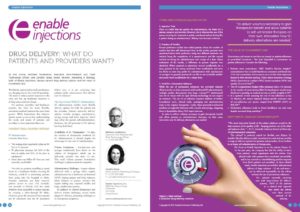
Drug Delivery: What Do Patients and Providers Want?
In this article, originally published at OnDrugDelivery, Matthew Huddleston and Jennifer Estep discuss current drug delivery options and the value of convenient care.
Drug Delivery: What Do Patients and Providers Want?
Worldwide, patient and provider preferences are changing due to the covid-19 pandemic. The need to reduce patient exposure to the virus and free up healthcare resources is driving unprecedented change.
For patients, providers and healthcare systems, the need for more flexible, convenient medical treatment has never been greater. While innovations that improve patient access to care evolve, understanding the needs and wants of patients and providers is more important than ever.

OnDrugDelivery article: Drug Delivery: What Do Patients Want?
CURRENT DRUG DELIVERY OPTIONS
IV Administration
Consider these facts:
- The average time required to place an IV line is 13 minutes1
- IV placement attempts fail 26% of the time in adults and 54% of the time in paediatrics2
- More than one billion IV lines are used annually, worldwide3
Not only are patients unwilling to spend hours in a healthcare facility receiving IV infusions, covid-19 is preventing patients from going into the hospital or clinic. Creative solutions can help improve patient access to care. For example, one provider in Florida (US) has made infusions more accessible to cancer patients by creating a drive-through IV clinic. However, given the amount of time required per IV placement and the IV placement failure rate, it is not surprising that patients prefer subcutaneous (SC) delivery over IV infusion.4
The Step Forward With SC Administration
SC administration enables more flexible delivery options for both the patient and the provider. Current approved delivery options include syringes, autoinjectors, syringe pumps and bolus injectors, which may allow for patient self-administration. However, the full potential of SC delivery has been held back.
Availability of SC Therapeutics –
To date, the number of therapeutics marketed for SC administration is limited despite the advantages SC has over IV administration.
Volume Limitations –
Autoinjectors and syringes traditionally have limits on the volume of therapeutic which can be delivered, typically less than 1.5 mL. This small volume presents formulation challenges to pharmaceutical companies.
Administration Challenges –
Larger volumes delivered with a syringe often require administration by a healthcare professional (HCP). Syringe pumps and bolus injectors allow delivery of greater volumes but require tubing sets, exposed needles and large, cumbersome systems.
In addition to limited therapeutics and delivery volume challenges, several myths plague SC delivery, presenting challenges to its widespread acceptance.
“To deliver volumes necessary to gain therapeutic benefit and allow patients to self-administer therapies on their own, innovative new SC delivery alternatives are needed.”
THREE SUBCUTANEOUS DELIVERY MYTHS
1. Injection Time
There is a belief that the quicker the administration, the better for a patient, caregiver and provider. However, this is often not the case. If the person receiving the treatment is mobile, untethered and not feeling like a patient during an administration,5 delivery time becomes irrelevant.
2. Number of Needles
Recent preference studies have asked patients about the number of needles that they will tolerate per dose. In the studies, patients were questioned about their preference using two different methods: one method being the completion of a questionnaire and the second method involving the administration and receipt of a dose. Upon evaluation of the results, a difference in patient response was identified. When required to administer several needlesticks for a dose, patients in the survey preferred fewer needlesticks and were less likely to state they prefer SC administration with autoinjectors or syringes.6 In general, patients do not like to see or handle needles7 and prefer fewer needlesticks for a single dose.
3. Need for a Permeation Enhancer
While the use of permeation enhancers has provided valuable efficiencies for in-clinic compared with traditional IV administration, multiple studies demonstrate that large volumes8,9,10 administered into the SC tissue with the right delivery technology do not require an enhancer. The use of an enhancer requires addition of further formulation work, clinical trials, packaging and administration steps to the original therapeutic. Lastly, these permeation-enhanced products are typically delivered with a needle and syringe, relegating them to hospital/in-clinic, HCP-supervised use.
In order to deliver volumes necessary to gain therapeutic benefit and allow patients to self-administer therapies on their own, innovative new SC delivery alternatives are needed.
THE VALUE OF CONVENIENT CARE
Convenience and access to care have an impact on patient adherence to prescribed treatments – but how impactful is convenience on patient adherence?
To read more, please visit the article at OnDrugDelivery at this link: https://www.ondrugdelivery.com/drug-delivery-what-do-patients-and-providers-want/
To learn more about ways the enFuse® enables convenient care for patients and providers, contact us.
